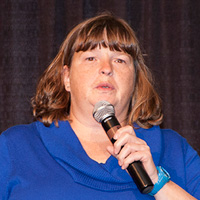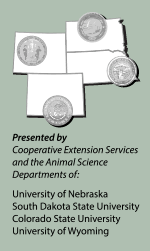Managing Cow Costs
by Troy Smith, field editor, Angus Journal
RAPID CITY, S.D. (Dec. 3, 2013) — What is your annual cow cost? What is your breakeven cost in terms of dollars per pound of weaned calf? Those were questions South Dakota State University (SDSU) Extension Beef Specialist Julie Walker posed to cow-calf producers attending the Range Beef Cow Symposium Dec. 3-5 in Rapid City, S.D. Walker said it’s not something that very many producers like to do, but many of them need to do a better job of accounting for production costs — all of them.

SDSU Extension Beef Specialist Julie Walker urged producers to create an enterprise budget for their cow-calf operations.
“Managing production costs is not just about spending less money. Being a low-cost producer doesn’t necessarily make you more profitable,” said Walker. “Lowering costs may also decrease production, decrease product quality or both, resulting in lower revenue. It takes time to measure and record details, but it enables you to make the best management decisions. The old saying is true, ‘You can’t manage what you don’t measure.’”
Walker urged producers to create an enterprise budget for their cow-calf operations. She recommended a budget including expenses associated with feed, reproduction, animal health, labor, other direct costs and overhead. It should also include an accounting of cull credits.
“Feed cost is the big one, and it always will be,” said Walker, adding that too many producers fail to include all costs associated with owned pasture or range and home-raised hay. “Be realistic. You have to include opportunity costs. What could you rent the pasture for? What could you sell the hay for?”
Another often-overlooked item is grazed crop residues on owned cropland. It, too, has an opportunity cost equal to the rental value, or the value of residues baled and sold.
Reproduction costs include money invested in replacement heifers or cows, breeding bulls and artificial insemination (AI). Walker reminded producers to remember depreciation and interest costs, as well as salvage value, when calculating total yearly cost for breeding bulls on a per cow basis.
Calculating other cost categories is fairly straightforward, but Walker urged producers to write it all down on paper or use a computer.
“Some producers say, ‘I work through it in my head,’ but it’s easy to double-count some things or leave out others,” she warned.
Instead of managing cow costs, Walker thinks producers should manage profit, which includes both expense and revenue. She advised producers to think about whether they are selling their product or marketing it.
“Webster’s Dictionary defines marketing as the process or technique of promoting, selling and distributing a product or service,” stated Walker. “Another way to improve profitability is through better marketing. Do you know how your cattle perform? Do you collect data? You need to know more about your cattle than he buyer does.”
Walker advised producers to take advantage of available programs for gathering information about how their cattle perform in the feedlot and the merit of the carcasses they produce. It can be done, she said, by enrolling representative groups of cattle in those programs.
Walker spoke Tuesday at RBCS XXIII. Visit the Newsroom at www.rangebeefcow.com/2013 to view her PowerPoint, read her proceedings paper or listen to her presentation.
---------------------
The RBCS is a biennial educational symposium offering practical production management information. It is sponsored by the Cooperative Extension Service and animal science departments of the University of Wyoming, South Dakota State University, Colorado State University and the University of Nebraska.
Comprehensive coverage of the symposium is available online at www.rangebeefcow.com. Compiled by the Angus Journal editorial team, the site is made possible through sponsorship of LiveAuctions.tv and the cooperation of the host committee.
Editor’s Note: This article was written under contract or by staff of the Angus Journal. To request reprint permission and guidelines, contact Shauna Rose Hermel, editor, at 816-383-5270.
.


